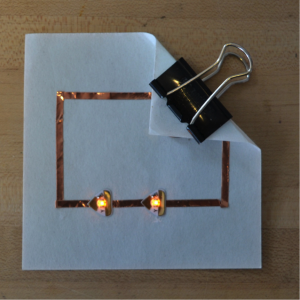Have you ever noticed that the brightness of LEDs change differently when you connect them in different ways? This tutorial explains the differences between series and parallel connections.
Series Connections
When components are connected to one another in a continuous loop, like beads on a necklace, it is called a series connection. In a series circuit, there is only one path current can follow, so the same amount of electricity (called current) goes through every single component in the loop.


image: Two LEDs connected in series, 6V
When talking about circuit stickers, this means that the negative side of one LED sticker is connected to the positive side of the other.
In a series circuit, there is only one path current can follow, so the same amount of current goes through every single component.
Each LED requires between 2V to 3V depending on the color. So as you add more LEDs in series to your circuit, the total required voltage required to power all the LEDs in the loops goes up.

image:Three LEDs connected in series, 6V
This means that when two LEDs of the same color are in series, they need twice the voltage (or potential difference) to shine just as bright as a one-battery, one-LED circuit.
In Chibitronics tutorials we often use 3V coin cell batteries. This creates a problem when you have more than one LED in series. LEDs that work separately might seem like they are not working when connected in series, but in reality they just need more voltage from the battery .
Parallel Connections
When the positive sides of the components are connected to each other on one side, and the negative sides on the other, this is called a parallel connection.
In a parallel circuit, there are many paths current can follow.

image: 2 paths, indicated by arrows
The same voltage exists in every branch, which is equal to the voltage provided by the battery.
In this circuit, 3 volts go through every LED.
Because the battery provides more voltage, it has a shorter life when compared to a battery connected to two LEDs in series.
In a parallel circuit, even if one branch is not working, the others will continue to work.
While in a series circuit, all components have to be connected properly for the whole circuit to work.
Battery Connections
Batteries connected in parallel will provide the same voltage as a single one, but last longer. When connected in series, the total voltage provided adds up, which means when you connect two 3V batteries in series, they will provide 6V in total and make the LEDs shine brighter. In the image below, the upper LED is connected to 2 batteries in series so it’s brighter than the LED below.
Here’s a visual explanation from Love to Code Volume 1! (click for PDF)
Want to learn more about circuits? Here are some resources you might enjoy:
Khan Academy:
https://www.khanacademy.org/science/physics/circuits-topic
Sparkfun:
https://learn.sparkfun.com/tutorials/series-and-parallel-circuits








